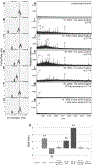Functional Peptidomics: Stimulus- and Time-of-Day-Specific Peptide Release in the Mammalian Circadian Clock
- PMID: 29901982
- PMCID: PMC6125129
- DOI: 10.1021/acschemneuro.8b00089
Functional Peptidomics: Stimulus- and Time-of-Day-Specific Peptide Release in the Mammalian Circadian Clock
Abstract
Daily oscillations of brain and body states are under complex temporal modulation by environmental light and the hypothalamic suprachiasmatic nucleus (SCN), the master circadian clock. To better understand mediators of differential temporal modulation, we characterize neuropeptide releasate profiles by nonselective capture of secreted neuropeptides in an optic nerve horizontal SCN brain slice model. Releasates are collected following electrophysiological stimulation of the optic nerve/retinohypothalamic tract under conditions that alter the phase of the SCN activity state. Secreted neuropeptides are identified by intact mass via matrix-assisted laser desorption/ionization time-of-flight mass spectrometry (MALDI-TOF MS). We found time-of-day-specific suites of peptides released downstream of optic nerve stimulation. Peptide release was modified differentially with respect to time-of-day by stimulus parameters and by inhibitors of glutamatergic or PACAPergic neurotransmission. The results suggest that SCN physiology is modulated by differential peptide release of both known and unexpected peptides that communicate time-of-day-specific photic signals via previously unreported neuropeptide signatures.
Keywords: Circadian clock; SCN; mass spectrometry; neuropeptidomics; optic nerve; suprachiasmatic nucleus.
Figures



References
-
- Hastings MH; Maywood ES; Reddy AB, Two decades of circadian time. J Neuroendocrinol 2008, 20 (6), 812–9. - PubMed
-
- Robinson I; Reddy AB, Molecular mechanisms of the circadian clockwork in mammals. FEBS Lett 2014, 588 (15), 2477–83. - PubMed
-
- Rosenwasser AM; Turek FW, Neurobiology of Circadian Rhythm Regulation. Sleep Med Clin 2015, 10 (4), 403–12. - PubMed
-
- Abrahamson EE; Moore RY, Suprachiasmatic nucleus in the mouse: retinal innervation, intrinsic organization and efferent projections. Brain Res 2001, 916 (1–2), 172–91. - PubMed
Publication types
MeSH terms
Substances
Grants and funding
LinkOut - more resources
Full Text Sources
Other Literature Sources

